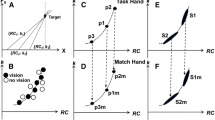Abstract
The present study used a force-matching task to measure how accurately subjects could match a force using different muscle groups. Forces ranging in magnitude from 2 to 10 N were produced and matched by three muscle groups: the elbow flexors, the forearm and hand muscles involved in the palmar prehensile grasp, and the index finger flexors. The ability to match forces was considered in terms of precision, that is, how closely the matching forces approximated the reference force produced on the contralateral side, and accuracy, which is the reproducibility of the matching force estimates. The results indicated that the perceived magnitude of forces varied as a function of the muscle group generating the force. Forces produced by the index finger flexors were consistently overestimated in magnitude when matched by elbow flexion forces, and elbow forces were underestimated when matched by flexing the index finger. When evaluated in terms of constant and absolute errors, the index finger flexors were the most precise matching muscle group and the elbow flexors the least precise. These results suggest that forces are perceived relatively, and are scaled with reference to the operating range of the muscles. They also indicate that there is little perceptual constancy in the perceived magnitude of forces generated by different muscle groups.






Similar content being viewed by others
References
Cafarelli E, Bigland-Ritchie B (1979) Sensation of static force in muscles of different length. Exp Neurol 65:511–525
Cafarelli E, Layton-Wood J (1986) Effect of vibration on force sensation in fatigued muscle. Med Sci Sports Exerc 18:516–521
Comaish S, Bottoms E (1971) The skin and friction: Deviations from Amonton's laws, and the effects of hydration and lubrication. Br J Derm 84:37–43
Gandevia SC (1996) Kinesthesia: roles for afferent signals and motor commands. In: Rowell L, Shepherd JT (eds) Handbook of physiology, Sect 12. Exercise: regulation and integration of multiple systems. Oxford University Press, New York, pp 128–172
Gandevia SC, Kilbreath SL (1990) Accuracy of weight estimation for weights lifted by proximal and distal muscles of the human upper limb. J Physiol 423:299–310
Gandevia SC, Kilbreath SL (1995) Limitations in the neural control of human thumb and finger flexors. In: Ferrell WR, Proske U (eds) Neural control of movement. Plenum, New York, pp 79–85
Gandevia SC, McCloskey DI (1977) Changes in motor commands, as shown by changes in perceived heaviness, during partial curarization and peripheral anaesthesia in man. J Physiol 272:673–689
Hall LA, McCloskey DI (1983) Detections of movements imposed on finger, elbow and shoulder joints. J Physiol 335:519–533
Henningsen H, Ende-Henningsen B, Gordon AM (1995) Asymmetric control of bilateral isometric finger forces. Exp Brain Res 105:304–311
Jami L (1992) Golgi tendon organs in mammalian skeletal muscle: functional properties and central actions. Physiol Rev 72:623–666
Johansson RS, Westling G (1987) Signals in tactile afferents from the fingers eliciting adaptive motor responses during precision grip. Exp Brain Res 66:141–154
Jones LA (1986) The perception of force and weight: theory and research. Psychol Bull 100:29–42
Jones LA (1989) Matching forces: constant errors and differential thresholds. Perception 18:681–687
Jones LA (1995) The senses of effort and force during fatiguing contractions. In: Gandevia SC, Enoka RM, McComas AJ, Stuart DG, Thomas CK (eds) Fatigue: neural and muscular mechanisms. Plenum, New York, pp 305–313
Jones LA (2000) Visual and haptic feedback in the control of force. Exp Brain Res 130:269–272
Jones LA, Hunter IW (1983) Effect of fatigue on force sensation. Exp Neurol 81:640–650
Kilbreath SL, Gandevia SC (1992) Independent control of the digits: changes in perceived heaviness over a wide range of forces. Exp Brain Res 91:539–542
Kilbreath SL, Gandevia SC (1993) Neural and biomechanical specializations of human thumb muscles revealed by matching weights and grasping objects. J Physiol 472:537–556
Mai N, Schreiber P, Hermsdörfer J (1991) Changes in perceived finger force produced by muscular contractions under isometric and anisometric conditions. Exp Brain Res 84:453–460
Martin BJ, Armstrong TJ, Foulke JA, Natarajan S, Klineberg E, Serina E, Rempel D (1996) Keyboard reaction force and finger flexor electromyograms during computer keyboard work. Hum Factors 38:654–664
McCloskey DI (1981) Corollary discharges: motor commands and perception. In: Brooks VB (ed) Handbook of physiology: the nervous system, vol 2. American Physiological Society, Bethesda, pp 1415–1447
McCloskey DI, Ebeling P, Goodwin GM (1974) Estimation of weights and tensions and apparent involvement of a "sense of effort". Exp Neurol 42:220–232
McCloskey DI, Cross MJ, Honner R, Potter EK (1983) Sensory effects of pulling or vibrating exposed tendons in man. Brain 106:21–37
Roland PE, Ladegaard-Pedersen H (1977) A quantitative analysis of sensations of tension and of kinesthesia in man. Brain 100:671–692
Soechting JF (1982) Does position sense at the elbow reflect a sense of elbow joint angle or one of limb orientation? Brain Res 248:392–395
Acknowledgement.
This research was supported by grant NS-40836 from the National Institutes of Health.
Author information
Authors and Affiliations
Corresponding author
Rights and permissions
About this article
Cite this article
Jones, L.A. Perceptual constancy and the perceived magnitude of muscle forces. Exp Brain Res 151, 197–203 (2003). https://doi.org/10.1007/s00221-003-1434-4
Received:
Accepted:
Published:
Issue Date:
DOI: https://doi.org/10.1007/s00221-003-1434-4




